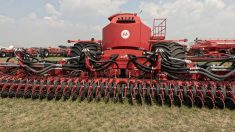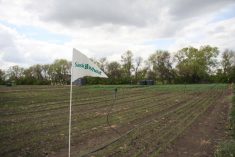As Wade McAllister heads into his second full seeding season this year with a single rank 60-foot drill on 15-inch row spacing, he is convinced there are more factors that contribute to farm profitability than just yield.
The central Alberta farmer agrees that, yes, yield is important, but with the new drill — which is lower cost, requires reduced tractor horsepower to operate and also delivers several other agronomic benefits as he grows cereal, oilseed and pulse crops — he says there are multiple savings that more than outweigh a slight yield reduction.
Read Also

Claas brings 1000 Series SP forage harvesters to Canada
In mid-August, Claas unveiled its new line of Jaguar forage harvesters at an event in Visalia, California, deep in the heart of that state’s dairy region.
Just off the top, he figures savings of at least $200,000 in capital costs and then when he factors in other reduced input costs and agronomic benefits, a two- or three-bushel reduction in wheat yield isn’t that big of a deal. (See ‘A whole new approach to on-farm research’.)
As McAllister and his brother, Scott, who own Antler Valley Farm near Innisfail, just south of Red Deer, Alta., made plans in early 2021 to buy a 60-foot SeedMaster Ultra SR (single rank) air drill, the biggest question in their minds was whether they could seed CPS wheat with the drill that only came with 15-inch row spacing and still maintain yield. Single rank means all the openers are on one tool bar for the full 60-foot width. The general thinking was they shouldn’t or couldn’t grow a high-yielding wheat crop on 15-inch row spacing — too much space, too much tillering.

“Everyone said to use narrow spacing, go for 7.5-inch spacing,” says McAllister. “First of all, it is hard to find a 7.5-inch drill and, secondly, with crop residue on our land, that narrow spacing doesn’t work as well for us.”
The McAllisters had been seeding crops for years with a 50-foot wide Flexicoil air seeder with 10-inch row spacing. And it worked fine. But to get the seeding capacity on their 4,000-acre farm, that drill was outfitted with two seed tanks (810-bushel capacity total), making the whole system about 120 feet long. It took a lot of horsepower to operate it.
“It was huge, it was a lot of equipment,” says McAllister. “When I made a turn on the headland, as the tractor came around it would be even with the second tank on the seeding system.”
The McAllisters were attracted to the SeedMaster Ultra SR drill not because of the wider row spacing, but mainly because it was a much simpler seeding system — fewer moving parts. The wider row spacing was a benefit in working through what can be heavy crop residue on their farm. The drill has rotating spoked wheels between the openers that move crop residue to the side, so the openers don’t get hung up on trash.
The 60-foot Ultra SR tool bar has 48 openers versus “a more conventional” seeding tool with 10-inch spacing and three or four ranks carrying 72 openers. “When it comes time to replace openers, there are much fewer and that’s a significant savings,” says McAllister.
Their Ultra SR came with a single 750-bushel capacity tank, which eliminated the need for a second seed tank. The whole unit is 43 feet long rather than 120 feet long (much easier to park in the shed after seeding). Other features McAllister likes — there are no pressurized tanks, and with direct-seed metering there is no distribution manifold. It also has a single 36-gallon-per-minute hydraulic pump rather than the two pumps used on the old system.

He can easily operate the Ultra SR with a 375-horsepower tractor rather than a 550- to 600-horsepower tractor needed for the Flexicoil system. The McAllisters sold their 620-horsepower quad tractor that had 1,700 hours, and with that money bought a 420-horsepower, wheeled tractor with 300 hours. “We got a smaller tractor that was five years and 1,400 hours newer for the same money, and it will be more fuel-efficient as well.”
McAllister figures a comparable standard 50-foot air drill with 7.5-inch row spacing would have cost between $100,000 to $200,000 more than what he paid for the 60-foot Ultra SR.
“I have a friend who just bought a new 50-foot drill that cost $580,000 and then he had to spend another $100,000 to upgrade his tractor horsepower,” says McAllister. “We easily saved $200,000 or more on the capital costs, and operating costs will be lower as well.”
What about performance?
It’s a simpler, lower cost, seeding implement, but can it get the seeding job done? McAllister was impressed with that, too. In their area of central Alberta, the McAllisters want a direct-seeding system to help conserve soil moisture and to retain soil carbon and protect soil health. Most years they do a fall heavy harrow to better distribute crop residue and then direct seed in the spring.
McAllister says the Ultra SR is designed to handle crop residue and deliver “very uniform seed placement that results in perfectly uniform crop emergence across the full width of the machine.”
Back to his original concern about wheat yields on the wider row spacing. Of the main crops they grow — canola, wheat, barley as well as hybrid fall rye — he was most concerned that the wider row spacing would allow the wheat to tiller too much, resulting in lower yields.

With wider row spacing, canola tends to branch out and, likely, produce more seed. McAllister wasn’t worried about the barley tillering and with the fall rye, since it has an extended growing season (August to August), its tillers have plenty of time to grow and produce seed.
During the 2021 growing season, he conducted an on-farm research trial with field-scale plots of CPS Penhold wheat seeded on both 15-inch and 7.5-inch row spacing. Based on the 1,000-kernel weight formula, he calculated a wheat seeding rate to produce a standing crop with 38 plants per square foot on both the wide and narrow row spacing. It was a properly designed and monitored research trial that showed the narrow row spacing produced on average only three bushels more per acre than the wide row spacing. Depending on the year and CPS wheat values, he figures that could be about a $15-per-acre difference.
At the same time, McAllister estimated his canola yielded between five and 10 bushels more per acre on the wider row spacing just because it was able to branch out more and produce more pods. And with uniform seed placement and germination, he can seed canola at three pounds per acre, which is about two pounds per acre less than most recommendations (that in itself is worth about $24 per acre) and still meet Canola Council of Canada recommendations of achieving a plant stand of seven to eight plants per square foot.
While three bushels of wheat is nothing to laugh at, McAllister says several other benefits of the single rank seeding system and wider row spacing more than cover the value of those three bushels — he points to the reduced capital and operating costs mentioned earlier.
And, with the improved air flow through the standing crops due to the wider row spacing, disease pressure could be reduced creating the potential to decrease or eliminate fungicide applications in some crops. Depending on the product, that could be savings ranging from $8 to $15 per acre.
“If wheat was the only crop we were growing, I’d have to rethink that seeding system,” he says. “But wheat is roughly one-third of the total acres. It appears the canola yields improved, and I suspect barley was either the same or better as well.
“If I think about the value of three bushels, if the combine isn’t set properly, a person could lose three bushels per acre pretty easily there,” he says. “And if we don’t pay attention to marketing, that’s another area where the value of three bushels could be lost.
“Often we think about yield, yield, yield, but there are several other factors that can more than compensate for a slight yield reduction and improve profitability,” he says.
While he is impressed with the first year of results, McAllister figures it will take three or four years of field operations to fully evaluate the value of the single rank, wider row spacing air seeding system.
















